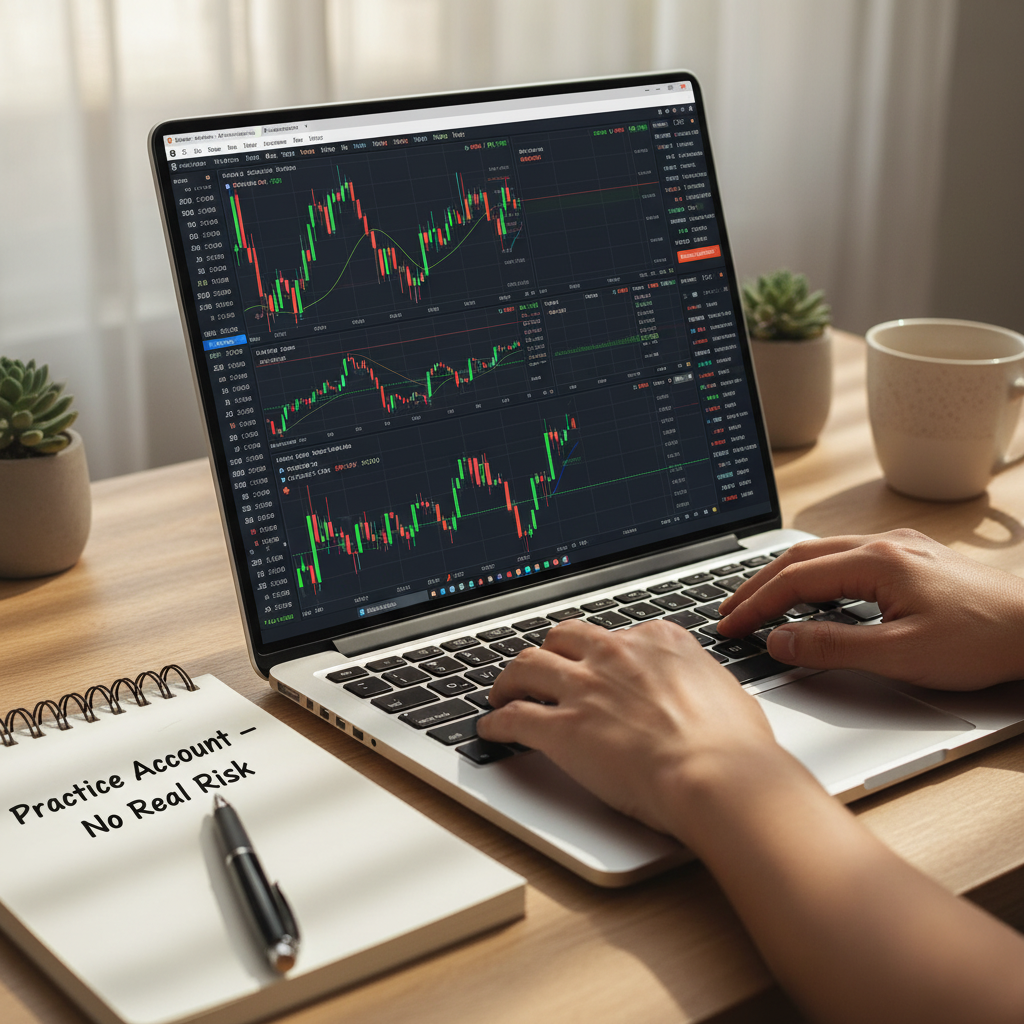Gold trading in the UAE is an interesting business. The gleaming allure of gold and the dynamic pulse of the foreign exchange (Forex) market have long captivated investors in the UAE. In a region synonymous with financial ambition, the idea of trading these markets is powerful. Yet, for many beginners, this ambition is quickly met with a wall of confusing jargon, complex charts, and a very real fear of losing hard-earned money. Is forex trading complicated? How do you even start trading gold in the UAE without getting overwhelmed?
If you’re feeling this way, you are not alone. The path to becoming a trader can seem foggy and fraught with risk.
This is why we’ve created the Definitive UAE Trader’s Blueprint. This is not just another article; it’s a clear, safe, step-by-step guide designed specifically for beginners in Dubai and across the UAE. We will demystify the entire process, from understanding the absolute basics to navigating local regulations and managing your risk. By the end of this guide, you’ll have the confidence and the roadmap to begin your trading journey safely.
What is Gold Forex Trading? The Absolute Basics for Beginners
Before you can trade confidently, you need to understand the fundamentals. Let’s break down the core concepts and cut through the jargon. The goal here isn’t to make you an expert overnight, but to give you a solid foundation so you know exactly what you’re dealing with.
Understanding the Forex Market: More Than Just Money
The Foreign Exchange market, or Forex (FX), is the largest and most liquid financial market in the world, with trillions of dollars exchanged every day. At its core, it’s a global marketplace for exchanging national currencies.
Think about it this way: if you’ve ever travelled from the UAE to the US, you’ve exchanged your Emirati Dirhams (AED) for US Dollars (USD). In doing so, you participated in the forex market. Forex traders do the same thing, but on a digital platform, aiming to profit from the changing values of these currencies against one another. For a more detailed overview, a great resource is this Introduction to Forex Trading from Investopedia.

What is XAUUSD? Trading Gold Without Owning a Bar
In the world of forex, everything is traded in pairs. When you see the symbol XAUUSD, it simply represents the price of Gold (XAU) valued against the US Dollar (USD). So, if XAUUSD is priced at $2,400, it means one ounce of gold is worth 2,400 US dollars.
Crucially, when you trade XAUUSD, you are not buying a physical bar of gold to store in a vault. Instead, you are typically trading a Contract for Difference (CFD). A CFD is a financial contract that allows you to speculate on the future price movement of an asset—in this case, gold—without actually owning it.
- If you believe the price of gold will rise, you “buy” or go “long” on XAUUSD.
- If you believe the price of gold will fall, you “sell” or go “short” on XAUUSD.
This method uses leverage, which allows you to control a large position with a smaller amount of capital. While leverage can amplify profits, it also significantly amplifies losses, making it a double-edged sword that beginners must handle with extreme care.
Navigating the UAE’s Regulatory Landscape: A Trader’s Safety Guide
This is the most important section for any aspiring trader in the UAE. Your financial safety depends on understanding and respecting the local regulatory environment. Unlike in some other regions, the UAE has a robust and clear system designed to protect investors. Trading with a regulated broker is not just a suggestion—it is the only way to ensure your funds are protected.
The UAE has two primary, top-tier financial regulators. A legitimate broker serving UAE residents will be licensed by at least one of them.
The SCA: Your Onshore Regulator
The Securities and Commodities Authority (SCA) is the federal government regulator for the UAE’s onshore financial markets. Any brokerage firm that wants to operate and serve clients across the UAE (outside of specific financial free zones) must be licensed by the SCA.
The SCA’s mandate is to protect investors. As they state, “The SCA maintains a public register of all companies it has licensed… The authority advises investors to exclusively engage with firms that are licensed by the SCA to ensure they are afforded the legal protections available under UAE law” [1]. Engaging with an unlicensed entity means you are operating without this crucial safety net. Before you even consider a broker, your first step should be to check their license on the SCA’s official register.
You can stay updated on unlicensed entities by checking the official UAE Securities and Commodities Authority (SCA) Alerts.
The DFSA: Regulating Dubai’s International Financial Centre (DIFC)
Dubai is home to the Dubai International Financial Centre (DIFC), a major global financial hub that operates as an independent economic zone with its own legal system and courts. Financial services within the DIFC are regulated by the Dubai Financial Services Authority (DFSA).
The DFSA is an independent regulator known for its high, international standards. Brokers licensed by the DFSA are held to stringent rules regarding client fund protection, capital adequacy, and ethical conduct. According to the DFSA, “The DFSA provides a comprehensive Public Register to allow the public to verify which firms are licensed… only firms on this register are subject to its oversight and high regulatory standards” [2].
For brokers operating out of the DIFC, you can verify their status on the DFSA’s public register and review any consumer warnings on the Dubai Financial Services Authority (DFSA) Consumer Alerts page.

Your Step-by-Step Blueprint to Start Trading in the UAE
Now that you understand the basics and the critical importance of regulation, let’s walk through the practical steps to get started. This blueprint is designed to take you from a complete novice to placing your first practice trade with clarity and confidence.
Step 1: Choose a Safe & Regulated Broker in the UAE
Choosing the right broker is the most important decision you will make. The wrong choice can lead to high fees, poor service, or even the loss of your entire deposit. Do not be swayed by flashy marketing or promises of guaranteed profits. Instead, use this objective checklist.
Broker Safety Checklist for UAE Traders:
- Is it Regulated by the SCA or DFSA? This is non-negotiable. If the broker is not licensed by one of these two bodies, do not use it.
- Verify the License Number: Go to the SCA or DFSA public register (linked in the section above) and verify that the broker’s license is active and legitimate.
- Understand the Costs: Look for brokers with transparent fee structures. The main cost is usually the “spread” (the small difference between the buy and sell price), but also check for any commission fees or inactivity fees.
- Test the Platform: Does the broker offer a user-friendly trading platform like MetaTrader 4 (MT4) or MetaTrader 5 (MT5)? Is it stable and easy to navigate?
- Check Customer Support: Is their support team accessible and helpful? This is crucial if you run into any issues.
This focus on transparency and safety is echoed by the country’s top financial regulator. The Central Bank of the UAE (CBUAE) has established a Consumer Protection Framework that requires all licensed financial institutions to ensure “clear disclosure of risks associated with financial products and services” and to act in the best interest of their clients [3]. A good broker will take this responsibility seriously.
Step 2: Open Your Account – Start with a Demo First
Once you’ve shortlisted a few regulated brokers, the next step is to open an account. However, you should not deposit real money yet.
Every reputable broker offers a free demo account. This is a practice account funded with virtual money that allows you to use the real trading platform, see live market prices, and practice placing trades without any financial risk.
Starting with a demo account is the single best thing you can do to support the safety-first approach of this guide. It allows you to:
- Get comfortable with the trading platform’s interface.
- Practice opening and closing trades.
- Learn how to set Stop-Loss and Take-Profit orders (more on this below).
- Experience market volatility without the emotional stress of losing real money.
Treat your demo account seriously. Use it for at least a few weeks until you feel completely confident in the mechanics of trading.
Step 3: Placing Your First Gold (XAUUSD) Trade
After practicing in your demo account, you’re ready to walk through the steps of placing your first trade. Let’s use a hypothetical “buy” trade on XAUUSD as an example.
- Open the Order Window: In your trading platform (e.g., MT5), find the XAUUSD symbol and open a new order ticket.
- Select Your Volume (Lot Size): This determines the size of your trade. For beginners, it is critical to start with the smallest possible size, often called a “micro lot” (0.01). This minimizes your risk while you are learning.
- Set Your Stop-Loss: This is your safety net. A Stop-Loss is an order that automatically closes your trade if the price moves against you to a certain level. This is the most critical step for managing risk. You decide in advance the maximum amount you are willing to lose on this trade.
- Set Your Take-Profit: This is an order that automatically closes your trade when it reaches a specific profit target. It helps you lock in gains without letting greed take over.
- Execute the Trade: Once your Stop-Loss and Take-Profit are set, you can click “Buy” (if you think the price will go up) or “Sell” (if you think it will go down).
By setting your exit points before you even enter the trade, you remove emotion from the decision-making process and stick to a pre-defined plan.

Essential Risk Management & Simple Strategies for Beginners
Trading is not about winning every trade; it’s about managing your losses so that your wins are more meaningful. This section tackles the biggest fear of every new trader: losing money.
The goal of a new trader is not to make a million dollars. It’s to stay in the game long enough to learn how.
The Golden Rule: Never Risk More Than You Can Afford to Lose
The money you deposit into a trading account should be risk capital—money that, if lost, would not impact your daily life or financial stability.
A powerful technique used by professional traders is the 1-2% rule. This means you should never risk more than 1% to 2% of your total trading capital on any single trade. This simple rule is your best defense against catastrophic losses.
For example, if you have a $1,000 trading account, a 2% risk is just $20. By using a Stop-Loss, you can ensure that if a trade goes against you, your maximum loss is capped at that $20. This allows you to survive a string of losing trades and stay in the market to learn and improve.
Your Two Most Important Tools: Stop-Loss and Take-Profit Orders
We mentioned these in the step-by-step guide, but their importance cannot be overstated.
- Stop-Loss (SL): Your pre-defined exit point for a losing trade. It protects your capital and prevents a single bad trade from wiping out your account.
- Take-Profit (TP): Your pre-defined exit point for a winning trade. It enforces discipline and helps you secure profits according to your plan.
Using SL and TP orders on every single trade is the hallmark of a disciplined trader. It forces you to define your risk and reward before you enter the market, which is essential for long-term success.
Common Mistakes UAE Beginners Make (And How to Avoid Them)
Demonstrating experience means learning from the mistakes of others. Here are some of the most common pitfalls for new traders in the UAE and how you can sidestep them.
- Mistake: Using Too Much Leverage.
- Solution: Start with low leverage (e.g., 1:30 or 1:50) and always stick to the 1-2% risk rule per trade.
- Mistake: “Revenge Trading” after a Loss.
- Solution: Accept that losses are a normal part of trading. If you have a losing trade, step away from the screen and stick to your trading plan.
- Mistake: Trading Without a Plan.
- Solution: Before you trade, define your strategy. Know why you are entering a trade, where you will take profit, and where you will cut your losses.
- Mistake: Following Unverified Social Media “Gurus”.
- Solution: Do your own research. Base your decisions on your strategy and analysis, not on hype from anonymous accounts.

Gold & Forex Trading in the UAE: Frequently Asked Questions (FAQ)
Here are quick answers to some of the most common questions from beginners in the region.
Is Forex and Gold trading legal in the UAE?
Yes, trading forex and gold CFDs is completely legal in the UAE, provided you use a broker that is properly licensed and regulated by either the Securities and Commodities Authority (SCA) or the Dubai Financial Services Authority (DFSA). Always verify a broker’s license on their official public registers before depositing funds.
How much money do I need to start trading in Dubai?
Many regulated brokers in Dubai and the UAE offer accounts with minimum deposits as low as $100. However, the more important question is how much you can afford to lose. It is wise to start with a small amount of risk capital while you are learning the process and building your skills.
What are the best times to trade XAUUSD in the UAE?
Gold (XAUUSD) tends to be most active and volatile during the overlap of the London and New York trading sessions. This typically corresponds to the afternoon and early evening in the UAE, from approximately 4:00 PM to 8:00 PM Gulf Standard Time (GST). While this higher activity can present more trading opportunities, it also comes with increased risk.
Your Journey Starts Now
The world of gold and forex trading in the UAE is not an exclusive club for financial wizards. It is accessible to anyone who is willing to approach it with discipline, respect for risk, and the right education. You now have a clear blueprint to get started safely—one that prioritizes navigating local regulations, choosing a trustworthy broker, and protecting your capital above all else. The feeling of being overwhelmed can now be replaced with a feeling of empowerment.
Ready to take the next step? Don’t risk real money yet. Open a free demo account with a well-regulated broker and start practicing your strategy today.

This article is for informational purposes only and does not constitute financial advice. Trading Forex and CFDs on margin carries a high level of risk and may not be suitable for all investors. You should consider whether you understand how these products work and whether you can afford to take the high risk of losing your money.
References & Authoritative Sources
- Securities and Commodities Authority (SCA). (n.d.). SCA | Licensed Companies. Retrieved from https://www.sca.gov.ae/en/services/licensing/licensed-companies.aspx
- Dubai Financial Services Authority (DFSA). (n.d.). Public Register | Dubai Financial Services Authority. Retrieved from https://www.dfsa.ae/public-register
- Central Bank of the UAE (CBUAE). (n.d.). Consumer Protection | Central Bank of the UAE. Retrieved from https://www.centralbank.ae/en/our-services/consumer-protection/



